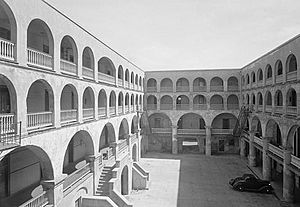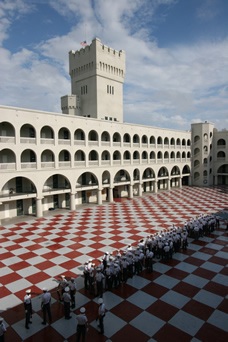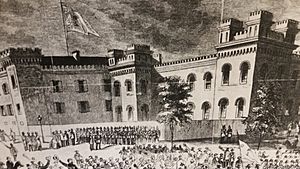History of The Citadel
The History of The Citadel is a story that began in the early 1800s. It started with state buildings called arsenals in Charleston, South Carolina and Columbia, South Carolina. These arsenals later became military schools, known together as the South Carolina Military Academy. The school played a big part in South Carolina's efforts during the American Civil War. Because of this, it became known for its strong military training and discipline.
After the Civil War, only the Charleston school reopened. It was first called The Citadel Academy. In 1910, its name changed to The Citadel. The school's reputation for good academics grew. In 1922, it moved to a new campus near Hampton Park. Since then, The Citadel has grown a lot. It welcomed minority students in the 1960s and women in the 1990s. Many of its graduates have become military officers, business leaders, and politicians.
Contents
The Start of The Citadel Academy
In 1829, South Carolina built an arsenal in downtown Charleston. This building, now part of Marion Square, was used to store weapons and ammunition. In 1830, federal troops from Fort Moultrie guarded it. State soldiers took over in 1832.
Over the next 10 years, other state arsenals moved their supplies to Charleston and Columbia. Governor John Richardson suggested turning these two arsenals into military schools. He based his idea on the Norwich University model. On December 20, 1842, the South Carolina Legislature agreed. They passed a law to change the arsenals into the South Carolina Military Academy.
The law said that students would form a military group. They would guard the public weapons and property at both arsenals.
The first 20 cadets arrived at the Citadel Academy in Charleston on March 20, 1843. This date is now celebrated as "Corps Day." At first, both schools ran separately. But in 1845, the Arsenal Academy in Columbia became a branch of the Citadel Academy in Charleston. First-year students went to the Arsenal, then moved to the Citadel Academy to finish their studies. Both schools stayed open during the Civil War. However, Union forces burned the Arsenal in Columbia, and it never reopened. The only building left from the Arsenal is now the Governor's Mansion.
Mexican–American War Service
Citadel cadets and teachers helped train South Carolina's Palmetto Regiment. This unit served in the Mexican–American War. Seventeen graduates and cadets fought with this group. In 1847, they joined U.S. Marines to enter the famous "Halls of Montezuma" in Mexico City. Lt. William J. Magill, from the first graduating class of 1846, was the first Citadel graduate to serve in the U.S. Army. He fought with future President Zachary Taylor in the Mexican War.
The American Civil War and After
In December 1860, South Carolina decided to leave the Union. Major Robert Anderson moved his U.S. troops to Fort Sumter. He asked the government for more soldiers. On January 9, 1861, Citadel Academy cadets on Morris Island fired on the U.S. ship Star of the West. They stopped it from reaching Fort Sumter with troops and supplies. Many people consider this to be the first shots of the American Civil War.
Along with Confederate soldiers, Citadel cadets also helped fire cannons at Charleston harbor. This happened during the attack on Fort Sumter on April 12–13, 1861. Many historians believe the first shot of the attack was fired by Second Lieutenant Henry S. Farley, who graduated in 1860.
On January 28, 1861, the cadets from both the Arsenal Academy and the Citadel Academy became part of the state's military. They were called the Battalion of State Cadets. The Academy continued to operate as a military school. However, classes were often stopped when the governor called the cadets to serve. Cadets helped set up and use large cannons, stood guard, provided security, and escorted prisoners.
The Battalion of State Cadets fought in eight battles during the Civil War. Because of their actions, the state of South Carolina allowed the flag of the South Carolina Corps of Cadets to carry special battle honors called streamers:
- Confederate States Army
- Star of the West, January 9, 1861
- Wappoo Cut, November 1861
- James Island, June 1862
- Charleston and Vicinity, July–October 1863
- James Island, June 1864
- Tulifinny, December 1864
- James Island, December 1864 – February 1865
- Williamston, May 1865

In December 1864, Governor Milledge Luke Bonham ordered the Battalion of State Cadets to Tulifinny Creek. This was near Yemassee, South Carolina. They joined a small Confederate force defending the Charleston and Savannah Railroad. On December 7 and 9, the entire group of cadets fought a much larger Union force. This included U.S. Marines in the Battle of Tulifinny. The cadets successfully defended the rail line. They forced the Union troops to leave. Eight cadets were injured, and one died later from his wounds.
The Battalion of State Cadets was praised for their discipline and bravery in battle. They earned the respect of the experienced soldiers who fought with them. Only The Citadel and The Virginia Military Institute have fought a full battle with their entire student bodies. The Citadel is also one of only seven colleges to receive a battle streamer for wartime service. During the Civil War, 43 graduates and 200 former cadets died in action.
On February 18, 1865, the school closed. Union troops entered Charleston and took over the campus. After the war, the school's leaders eventually got the campus back. Governor Johnson Hagood, a graduate from 1847, pushed for the college to reopen. The South Carolina Legislature passed a law to do so. In 1882, the school reopened with 185 cadets.
Into the 20th Century
During the Spanish–American War in 1898, more Citadel graduates volunteered than were needed. In World War I, Citadel graduates were among the first American troops to fight. They served with Australian, British, and French divisions. Several served bravely with the Marine Corps at the Battle of Belleau Wood.
In 1910, the college's name officially changed to "The Citadel, The Military College of South Carolina." The word "Academy" had become linked with high schools. People mistakenly thought the South Carolina Military Academy was a prep school. By then, the school had outgrown its buildings, even with many additions. In 1918, the city of Charleston offered the state 176 acres (71 hectares) on the Ashley River for a new campus. The condition was that the state would pay for construction. The state accepted on February 26, 1919, and set aside $300,000 for the new campus. In 1921, the head of the school's title changed from Superintendent to President. Colonel Oliver J. Bond was the last Superintendent and first President.
The college moved to its current location in 1922. The new campus first had only a barracks, an administration/classroom building, a dining hall, a gym, and a hospital. But it grew quickly over the next 30 years. New barracks were built in 1926, 1938, and 1942, allowing nearly 2,000 students. Between 1936 and 1939, a chapel, an armory/field house, a new dining hall, and two more academic buildings were added. Capers Hall, the main academic building, was built in 1951. A student activities building was added in 1957, and Daniel Library was finished in 1960. Deas Hall, for Physical Education, opened in 1976.
During World War II, almost the entire Class of 1944 was drafted into the military. Only two students graduated. By 1943, so many cadets had left to join the military that enrollment dropped to fewer than 500. But it soon increased with active duty service members attending through the Army Specialized Training Program. Of the 2,976 living graduates in 1946, all but 49 served their country. Citadel graduates were part of famous units like the Flying Tigers and the Doolittle Raiders. 280 graduates died in action, 67 were missing, and 65 became prisoners of war. After the war, veteran students using the GI Bill made the school's size reach record levels. At one point, they outnumbered cadets by more than 2 to 1.
Starting in the late 1980s, a big effort began to fix up older campus buildings and replace old ones. McAlister Field House was greatly rebuilt from 1987–89. Its seating capacity grew from 4,500 to 6,000. In 1991, a new dining hall and classroom building (Grimsley Hall) were finished. A major update of the administration building (Bond Hall) was completed in 1993. The beach house was rebuilt in 1995 after Hurricane Hugo destroyed it in 1989. A new barracks was built in 1996. Over the next ten years, three of the original four barracks were torn down and rebuilt. The newest academic building (Thompson Hall) was finished in 2003. The Holliday Alumni Center, south of campus, opened in 2001. Johnson Hagood Stadium has also seen big improvements. These include a new field house and rebuilding of the home stands. This new section has a press box tower with special seating.
The college's growth has allowed it to offer more and more academic programs. In 1916, only three majors were available. Now, 65 courses of study are offered for both undergraduate and graduate students. A Graduate School, the first in the Lowcountry area, was started in 1968. It aimed to meet the education needs of a growing city area. In recent years, new majors have been added in popular fields. These include Computer Science, Criminal Justice, Sports Management, Nursing, and Mechanical Engineering. Minors are now offered in many different subjects. These include Cybersecurity, East Asian Studies, International Relations, and African American Studies.
More building work continues. A new building for the business school and a rebuilt Capers Hall (for humanities and social sciences) are planned for 2018 and beyond. A rebuilt boat house and repairs to the beach house were also recently done.
Women in the Corps of Cadets
The Corps of Cadets was officially all male until 1996. In 1995, Shannon Faulkner won a legal case. A federal judge ordered that she be admitted. She arrived on campus for the first day of freshman orientation. However, she was admitted to the school's infirmary right after lunch. She stayed in the infirmary for less than a week and then left the school. A Supreme Court ruling in a lawsuit against Virginia Military Institute eventually made The Citadel officially change its admission policy to allow women.
The first group of four female cadets started in August 1996. Using credits from another school, Nancy Mace finished her degree in three years. She became the first female graduate in Corps history on May 9, 1999. Petra Lovetinska, who was born in the Czech Republic, was the first female graduate to attend for four years. She was also the first foreign female cadet. After becoming a U.S. citizen by an Act of Congress, she was the first female graduate to join the U.S. military as an officer. The other two women did not stay to finish their first year. By September 2013, women made up 7% of the Corps of Cadets. They made up 21% of all students at the school.
In the graduating class of 2012, Shanna M. Couch and Alexandria R. Burns were named First and Second Honor Graduates. This was the first time in the school's history that either of the top two graduates were women. Couch played soccer for four years. She was also the first woman at The Citadel to receive an NCAA Postgraduate Scholarship. Burns, from Pendleton, South Carolina, was recognized for her great academic success by the Anderson County Council in June 2012.
On March 21, 2018, The Citadel announced that Sara J. Zorn would be the Regimental Commander. This is the highest-ranking cadet position for the 2018–19 school year. She will be the first woman to hold this important role.




